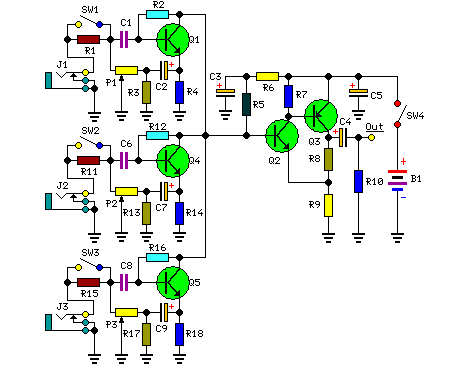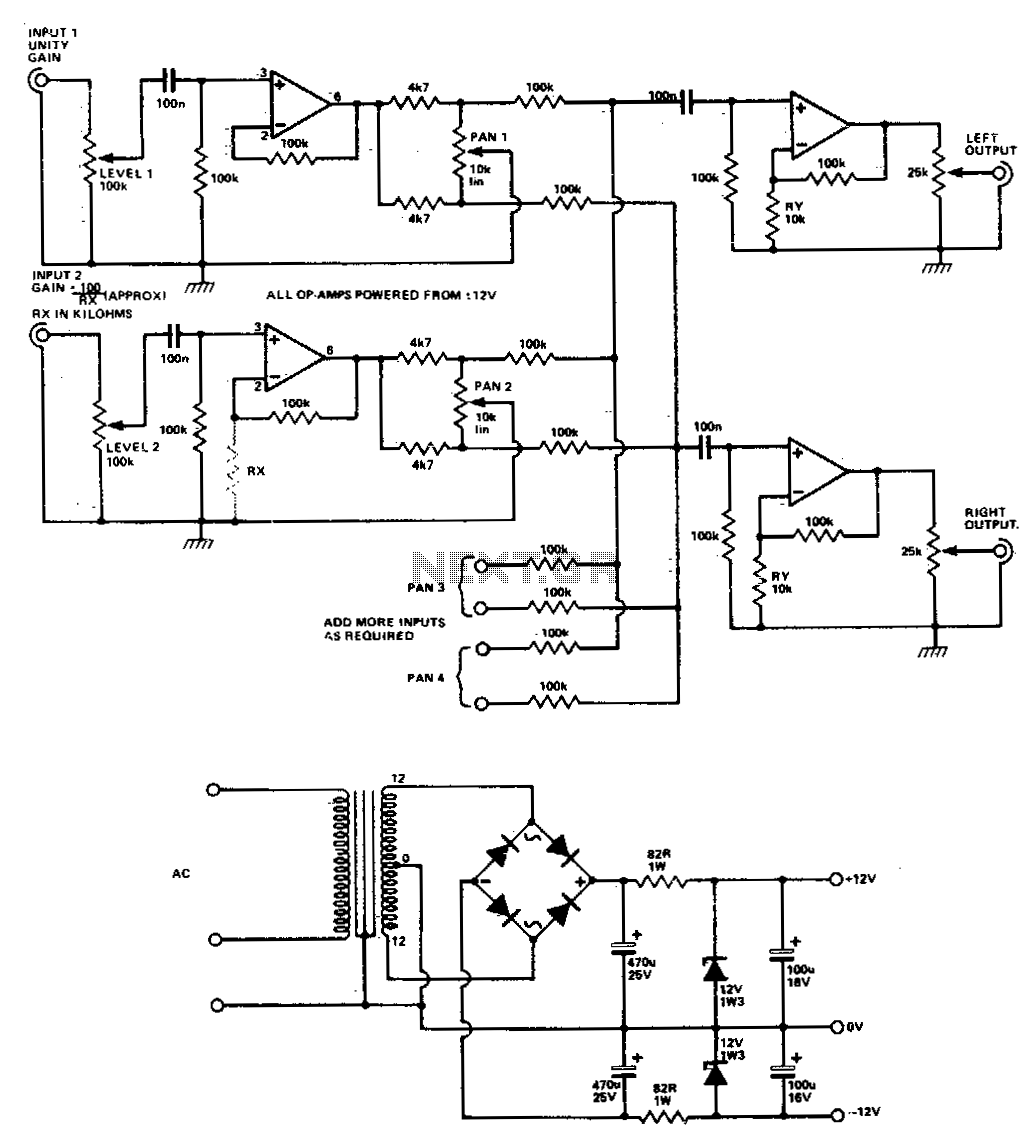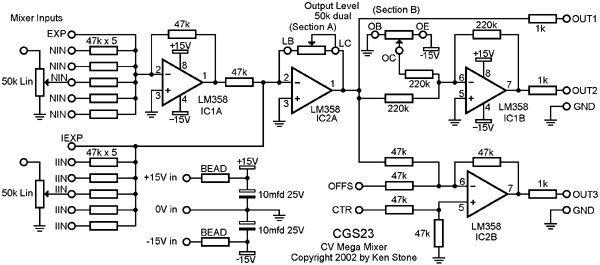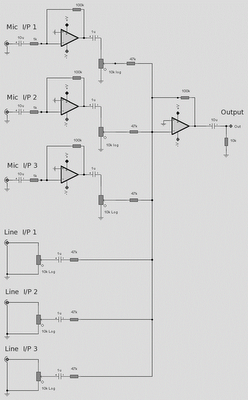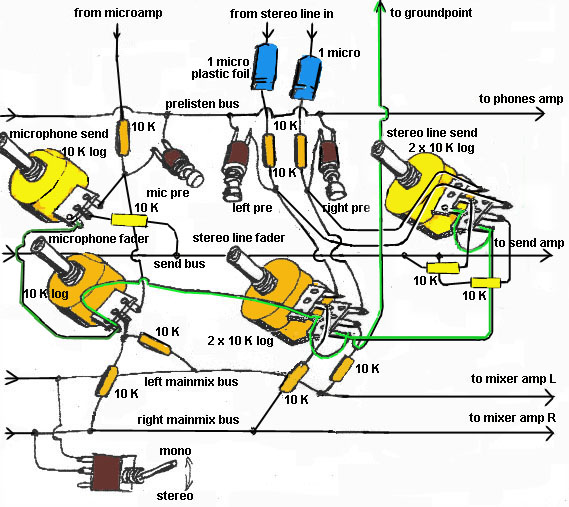
active mixer
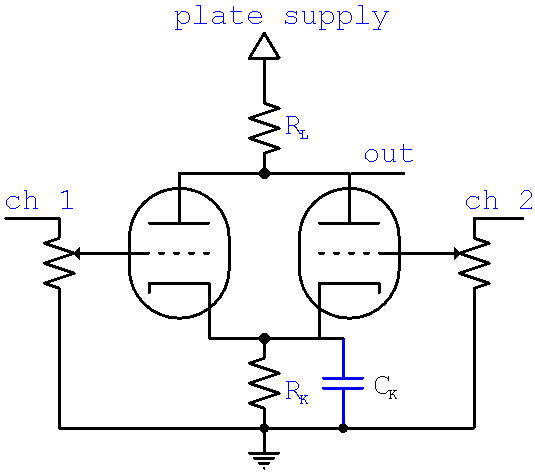
The calculator computes the gain and output impedance of a common plate load mixer. Each input channel controls a separate grid, which affects the plate current through the common plate load resistor RL and the cathode resistor RK. The optional cathode bypass capacitor CK increases gain by eliminating negative feedback. If a cathode bypass capacitor is used, the calculator assumes that it is large enough to short the cathode to ground at audio frequencies. As long as the triodes are not overdriven, the inputs are completely independent. Changes in control settings for one channel do not affect the signal characteristics of the other. Unlike a passive mixer, the circuit also provides substantial gain.
The common plate load mixer is a circuit configuration that allows for the mixing of multiple audio signals while maintaining individual channel control. In this design, each input channel is connected to a separate grid, which is crucial for modulating the plate current. The plate load resistor, denoted as RL, plays a significant role in determining the overall gain of the circuit, while the cathode resistor, RK, helps stabilize the operating point of the triodes.
When an optional cathode bypass capacitor, CK, is included in the circuit, it effectively eliminates negative feedback associated with the cathode resistor, thereby increasing the gain of the amplifier stage. The design assumes that this bypass capacitor is sufficiently large to provide a low impedance path to ground for audio frequencies, which enhances the performance of the mixer.
One of the notable advantages of this configuration is the independence of the input channels. Each channel operates without influencing the others, allowing for precise control over the audio signals being mixed. This is particularly advantageous in applications such as musical instrument amplifiers, where maintaining the integrity of each signal is critical.
The substantial gain provided by this active mixer distinguishes it from passive mixing circuits, which typically do not amplify the signals. The increased gain allows for a more dynamic and powerful output, making it suitable for various audio applications, including guitar amplifiers, as described in related literature on the subject.The calculator computes the gain and output impedance of a common plate load mixer. Each input channel controls a separate grid, which affects the plate current through the common plate load resistor RL and cathode resistor RK. The optional cathode bypass capacitor CK increases gain by eliminating negative feedback. If a cathode bypass capacitor i s used, the calculator assumes that it is large enough to short the cathode to ground at audio frequencies. (How large is large enough See our Cathode Bypass Capacitor Calculator. ) As long as the triodes are not overdriven, the inputs are completely independent. Changes in control settings for one channel, for example, do not affect the signal characteristics of the other.
Unlike a passive mixer, the circuit also provides substantial gain. Our online article The Gretsch Chet Atkins Active Mixer describes one of the ways that the circuit is used in a guitar amp. 🔗 External reference
The common plate load mixer is a circuit configuration that allows for the mixing of multiple audio signals while maintaining individual channel control. In this design, each input channel is connected to a separate grid, which is crucial for modulating the plate current. The plate load resistor, denoted as RL, plays a significant role in determining the overall gain of the circuit, while the cathode resistor, RK, helps stabilize the operating point of the triodes.
When an optional cathode bypass capacitor, CK, is included in the circuit, it effectively eliminates negative feedback associated with the cathode resistor, thereby increasing the gain of the amplifier stage. The design assumes that this bypass capacitor is sufficiently large to provide a low impedance path to ground for audio frequencies, which enhances the performance of the mixer.
One of the notable advantages of this configuration is the independence of the input channels. Each channel operates without influencing the others, allowing for precise control over the audio signals being mixed. This is particularly advantageous in applications such as musical instrument amplifiers, where maintaining the integrity of each signal is critical.
The substantial gain provided by this active mixer distinguishes it from passive mixing circuits, which typically do not amplify the signals. The increased gain allows for a more dynamic and powerful output, making it suitable for various audio applications, including guitar amplifiers, as described in related literature on the subject.The calculator computes the gain and output impedance of a common plate load mixer. Each input channel controls a separate grid, which affects the plate current through the common plate load resistor RL and cathode resistor RK. The optional cathode bypass capacitor CK increases gain by eliminating negative feedback. If a cathode bypass capacitor i s used, the calculator assumes that it is large enough to short the cathode to ground at audio frequencies. (How large is large enough See our Cathode Bypass Capacitor Calculator. ) As long as the triodes are not overdriven, the inputs are completely independent. Changes in control settings for one channel, for example, do not affect the signal characteristics of the other.
Unlike a passive mixer, the circuit also provides substantial gain. Our online article The Gretsch Chet Atkins Active Mixer describes one of the ways that the circuit is used in a guitar amp. 🔗 External reference
